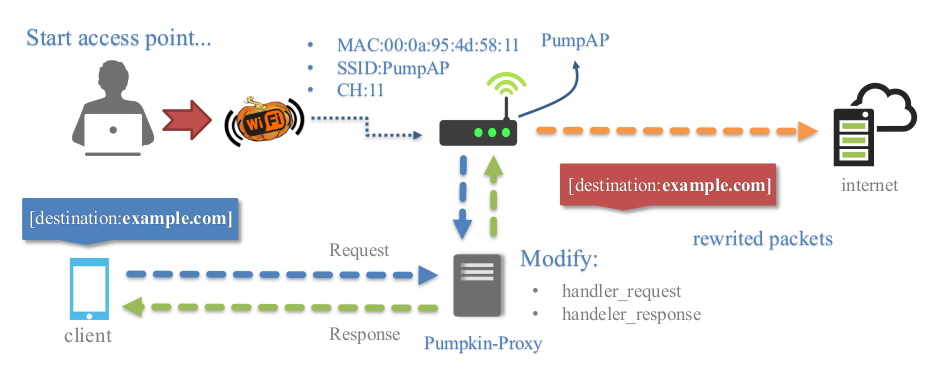


WiFi-Pumpkin - Framework for Rogue Wi-Fi Access Point Attack
Description
The WiFi-Pumpkin is a rogue AP framework to easily create these fake networks, all while forwarding legitimate traffic to and from the unsuspecting target. It comes stuffed with features, including rogue Wi-Fi access points, deauth attacks on client APs, a probe request and credentials monitor, transparent proxy, Windows update attack, phishing manager, ARP Poisoning, DNS Spoofing, Pumpkin-Proxy, and image capture on the fly. moreover, the WiFi-Pumpkin is a very complete framework for auditing Wi-Fi security check the list of features is quite broad.

Installation
git clone https://github.com/P0cL4bs/WiFi-Pumpkin.git
cd WiFi-Pumpkin
./installer.sh --install
or download .deb file to install
sudo dpkg -i wifi-pumpkin-0.8.8-all.deb
sudo apt-get -f install
refer to the wiki for Installation
Features
- Rogue Wi-Fi Access Point
- Deauth Attack Clients AP
- Probe Request Monitor
- DHCP Starvation Attack
- Credentials Monitor
- Transparent Proxy
- Windows Update Attack
- Phishing Manager
- Partial Bypass HSTS protocol
- Support beef hook
- ARP Poison
- DNS Spoof
- Patch Binaries via MITM (BDF-Proxy)
- LLMNR, NBT-NS and MDNS poisoner (Responder)
- Pumpkin-Proxy (ProxyServer (mitmproxy API))
- Capture images on the fly
- TCP-Proxy (with scapy)
- Moduled plugins and proxys
- Wireless Mode support hostapd-mana/hostapd-karma attacks
- Capitve-portals [new]
Donation
paypal:

Via BTC:
1HBXz6XX3LcHqUnaca5HRqq6rPUmA3pf6f
Plugins
| Plugin | Description |
|---|
| Dns2proxy | This tools offer a different features for post-explotation once you change the DNS server to a Victim. |
| Sstrip2 | Sslstrip is a MITM tool that implements Moxie Marlinspike's SSL stripping attacks based version fork @LeonardoNve/@xtr4nge. |
| Sergio_proxy | Sergio Proxy (a Super Effective Recorder of Gathered Inputs and Outputs) is an HTTP proxy that was written in Python for the Twisted framework. |
| BDFProxy | Patch Binaries via MITM: BackdoorFactory + mitmProxy, bdfproxy-ng is a fork and review of the original BDFProxy @secretsquirrel. |
| Responder | Responder an LLMNR, NBT-NS and MDNS poisoner. Author: Laurent Gaffie |
| PumpkinProxy | Intercepting HTTP data, this proxy server that allows to intercept requests and response on the fly |
| CaptivePortals | Captive-Portal allow the Attacker block Internet access for users until they open the page login page where a password is required before being allowed to browse the web. |
Transparent Proxy

Transparent proxies(mitmproxy) that you can use to intercept and manipulate HTTP traffic modifying requests and responses, that allow to inject javascripts into the targets visited. You can easily implement a module to inject data into pages creating a python file in directory "plugins/extension/" automatically will be listed on Pumpkin-Proxy tab.
Plugins Example Dev
from mitmproxy.models import decoded
from plugins.extension.plugin import PluginTemplate
class Nameplugin(PluginTemplate):
meta = {
'Name' : 'Nameplugin',
'Version' : '1.0',
'Description' : 'Brief description of the new plugin',
'Author' : 'by dev'
}
def __init__(self):
for key,value in self.meta.items():
self.__dict__[key] = value
self.ConfigParser = False
def request(self, flow):
print flow.__dict__
print flow.request.__dict__
print flow.request.headers.__dict__
host = flow.request.pretty_host
versionH = flow.request.http_version
if flow.request.pretty_host == "example.org":
flow.request.host = "mitmproxy.org"
self.send_output.emit("\n[{}][HTTP REQUEST HEADERS]".format(self.Name))
for name, valur in flow.request.headers.iteritems():
self.send_output.emit('{}: {}'.format(name,valur))
print flow.request.method
self.send_output.emit('[NamePlugin]:: this is model for save data logging')
def response(self, flow):
print flow.__dict__
print flow.response.__dict__
print flow.response.headers.__dict__
print flow.response.headers['Content-Type']
with decoded(flow.response):
print flow.response.content
flow.response.content.replace('</body>','<h1>injected</h1></body>')
del flow.response.headers["X-XSS-Protection"]
flow.response.headers["newheader"] = "foo"
About plugins
plugins on the wiki
TCP-Proxy Server
A proxy that you can place between in a TCP stream. It filters the request and response streams with (scapy module) and actively modify packets of a TCP protocol that gets intercepted by WiFi-Pumpkin. this plugin uses modules to view or modify the intercepted data that possibly easiest implementation of a module, just add your custom module on "plugins/analyzers/" automatically will be listed on TCP-Proxy tab.
from scapy.all import *
from scapy_http import http
from default import PSniffer
class ExamplePlugin(PSniffer):
_activated = False
_instance = None
meta = {
'Name' : 'Example',
'Version' : '1.0',
'Description' : 'Brief description of the new plugin',
'Author' : 'your name',
}
def __init__(self):
for key,value in self.meta.items():
self.__dict__[key] = value
@staticmethod
def getInstance():
if ExamplePlugin._instance is None:
ExamplePlugin._instance = ExamplePlugin()
return ExamplePlugin._instance
def filterPackets(self,pkt):
if pkt.haslayer(http.HTTPRequest):
http_layer = pkt.getlayer(http.HTTPRequest)
ip_layer = pkt.getlayer(IP)
print http_layer.fields['Method']
for item in http_layer.fields['Headers']:
print('{} : {}'.format(item,http_layer.fields['Headers'][item]))
print ip_layer.fields['src']
print ip_layer.fields['dst']
print http_layer
print ip_layer
return self.output.emit({'name_module':'send output to tab TCP-Proxy'})
About TCP-Proxy
TCP-Proxy on the wiki
About Captive Portals
the plugin Captive-Portal allow the Attacker mount a wireless access point which is used in conjuction with a web server and iptables traffic capturing rules to create the phishing portal. Users can freely connect to these networks without a password and will often be directed to a login page where a password is required before being allowed to browse the web.
Captive-portals on the wiki
Screenshots
Screenshot on the wiki
FAQ
FAQ on the wiki
Contact Us
Whether you want to report a bug, send a patch or give some suggestions on this project, drop us or open pull requests
https://discord.gg/jywYskR








